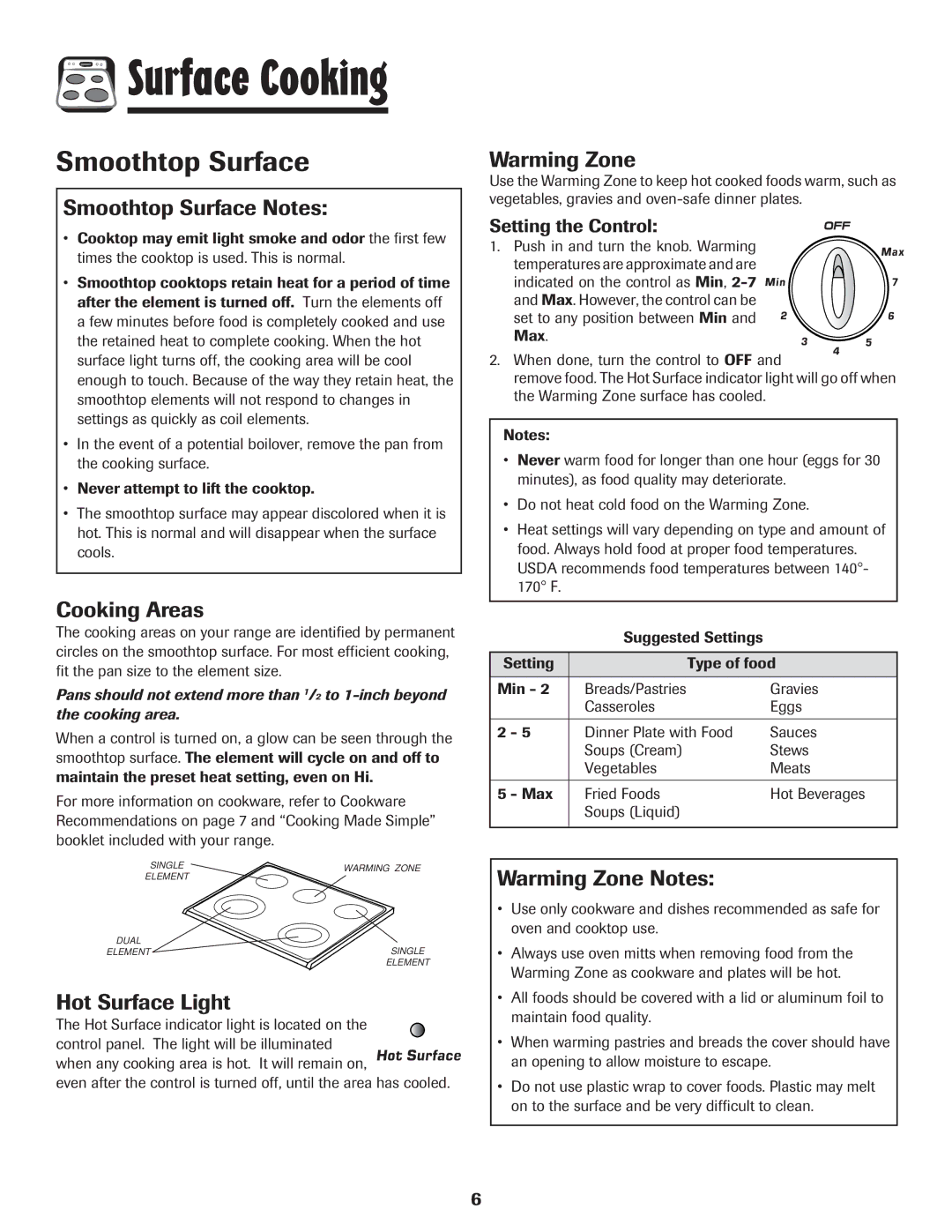
 Surface Cooking
Surface Cooking
Smoothtop Surface
Smoothtop Surface Notes:
•Cooktop may emit light smoke and odor the first few times the cooktop is used. This is normal.
•Smoothtop cooktops retain heat for a period of time after the element is turned off. Turn the elements off a few minutes before food is completely cooked and use the retained heat to complete cooking. When the hot surface light turns off, the cooking area will be cool enough to touch. Because of the way they retain heat, the smoothtop elements will not respond to changes in settings as quickly as coil elements.
•In the event of a potential boilover, remove the pan from the cooking surface.
•Never attempt to lift the cooktop.
•The smoothtop surface may appear discolored when it is hot. This is normal and will disappear when the surface cools.
Cooking Areas
The cooking areas on your range are identified by permanent circles on the smoothtop surface. For most efficient cooking, fit the pan size to the element size.
Pans should not extend more than 1/2 to
When a control is turned on, a glow can be seen through the smoothtop surface. The element will cycle on and off to maintain the preset heat setting, even on Hi.
For more information on cookware, refer to Cookware Recommendations on page 7 and “Cooking Made Simple” booklet included with your range.
SINGLE | WARMING ZONE | |
ELEMENT | ||
| ||
DUAL |
| |
ELEMENT | SINGLE | |
| ELEMENT |
Hot Surface Light
The Hot Surface indicator light is located on the control panel. The light will be illuminated
when any cooking area is hot. It will remain on,
even after the control is turned off, until the area has cooled.
Warming Zone
Use the Warming Zone to keep hot cooked foods warm, such as vegetables, gravies and
Setting the Control:
1. Push in and turn the knob. Warming temperatures are approximate and are indicated on the control as Min,
2.When done, turn the control to OFF and
remove food. The Hot Surface indicator light will go off when the Warming Zone surface has cooled.
Notes:
•Never warm food for longer than one hour (eggs for 30 minutes), as food quality may deteriorate.
•Do not heat cold food on the Warming Zone.
•Heat settings will vary depending on type and amount of food. Always hold food at proper food temperatures. USDA recommends food temperatures between 140°- 170° F.
Suggested Settings
Setting | Type of food | ||
Min - 2 | Breads/Pastries | Gravies | |
|
| Casseroles | Eggs |
|
|
|
|
2 | - 5 | Dinner Plate with Food | Sauces |
|
| Soups (Cream) | Stews |
|
| Vegetables | Meats |
|
|
|
|
5 | - Max | Fried Foods | Hot Beverages |
|
| Soups (Liquid) |
|
|
|
|
|
Warming Zone Notes:
•Use only cookware and dishes recommended as safe for oven and cooktop use.
•Always use oven mitts when removing food from the Warming Zone as cookware and plates will be hot.
•All foods should be covered with a lid or aluminum foil to maintain food quality.
•When warming pastries and breads the cover should have an opening to allow moisture to escape.
•Do not use plastic wrap to cover foods. Plastic may melt on to the surface and be very difficult to clean.
6
